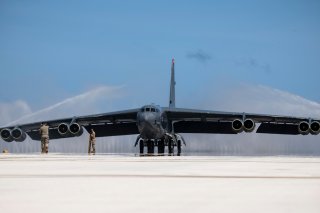NATO Takes to the Skies in Massive Nuclear Drills
The collection of fighters and bombers will focus on deterrence in northwestern Europe, as NATO draws attention to the pre-planned nature of the exercise.
NATO drills are set to begin this week and will feature a large assortment of airplanes from NATO member countries, including the U.S. Air Force's B-52 long-range strategic bombers.
A NATO news release explains that "exercise ‘Steadfast Noon’ involves 14 countries and up to 60 aircraft of various types, including fourth and fifth generation fighter jets, as well as surveillance and tanker aircraft. As in previous years, US B-52 long-range bombers will take part; this year, they will fly from Minot Air Base in North Dakota. Training flights will take place over Belgium, which is hosting the exercise, as well as over the North Sea and the United Kingdom. No live weapons are used."
Though the B-52, a Cold War-era aircraft, is the oldest airplane in active American military service (and one of the oldest military planes in service globally), it has not lost its relevance as a long-range bomber.
The NATO news release explains that "air forces from across NATO will exercise nuclear deterrence capabilities involving dozens of aircraft over north-western Europe starting on Monday." However, the news release is careful to explain that "the exercise, which runs until 30 October, is a routine, recurring training activity and it is not linked to any current world events," a nod to the ongoing conflict in Ukraine, instigated by Russia in late February. Steadfast Noon is hosted by a different NATO ally each year.
"This exercise helps ensure that the Alliance's nuclear deterrent remains safe, secure and effective," said NATO spokesperson Oana Lungescu.
"NATO's new Strategic Concept, adopted by Allied leaders at the Madrid Summit in June makes clear that ‘the fundamental purpose of NATO's nuclear capability is to preserve peace, prevent coercion and deter aggression,’" NATO’s statement added.
"It stresses that "as long as nuclear weapons exist, NATO will remain a nuclear alliance. NATO's goal is a safer world for all; we seek to create the security environment for a world without nuclear weapons," the statement continued.
Russian president Vladimir Putin has made several veiled references to the possibility of using nuclear weapons in Ukraine.
Some analysts believe that nuclear weapons—specifically, the smaller kind of so-called tactical nuclear weapons—are unlikely to benefit Russia on the battlefield. Ukrainian forces are widely dispersed along a very broad front line, negating the benefits of a large explosive blast.
Caleb Larson is a multimedia journalist and defense writer with the National Interest. A graduate of UCLA, he also holds a Master of Public Policy and lives in Berlin. He covers the intersection of conflict, security, and technology, focusing on American foreign policy, European security, and German society for both print and radio. Follow him on Twitter @calebmlarson
Image: DVIDS.

